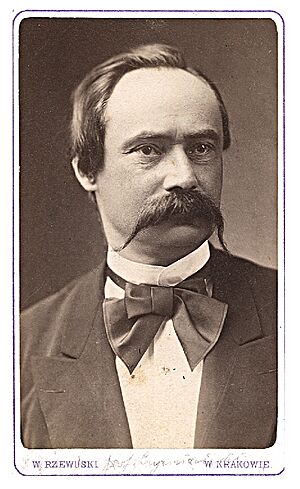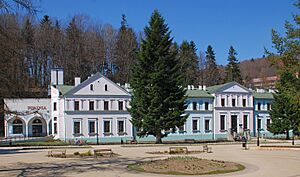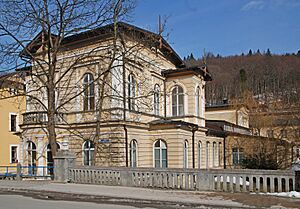Emil Czyrniański facts for kids
Quick facts for kids
Emil Czyrniański
|
|
|---|---|

Emil Czyrniański in 1878
(photograph by Walery Rzewuski) |
|
| Born | 26 January 1824 Florynka, Nowy Sącz County, Poland
|
| Died | 14 April 1888 (aged 64) |
| Resting place | Rakowicki Cemetery |
| Nationality | Lemko-Polish |
| Citizenship | Austrian |
| Alma mater | Technische Akademie Lemberg |
| Known for | co-founding of Polish Academy of Learning, Chemical nomenclature in Polish |
| Spouse(s) | Freiin Maria Stelzhammer |
| Children | Maria Krystyna (mother of Jozef Retinger) |
| Awards | Doctor Honoris Causa 1859 from Jagiellonian University |
| Scientific career | |
| Fields | General chemistry and pharmacy |
| Institutions | Jagiellonian University |
Emilian (also known as Emil) Czyrniański (born January 26, 1824 – died April 14, 1888) was an important Polish chemist. He was from the Lemko people. He wrote about science and was the head, or rector, of the Jagiellonian University. He also helped start the Polish Academy of Learning.
Emil Czyrniański is famous for creating the way chemicals are named in Polish, which is called chemical nomenclature. His grandson, Józef Retinger, became a very important political activist and writer.
Early Life
Emil Czyrniański was born on January 26, 1824, in a place called Florynka, in Nowy Sącz County, Poland. His family was Lemko. His father was a Greek Catholic parish priest and also checked on local schools.
After finishing school, Emil first thought about becoming a priest. He studied theology in Przemyśl. In 1844, he started studying at Lviv University. But after only two months, he got very sick and had to stop.
When he returned to Lwów in 1846, he became very interested in natural science. He decided to change his career path. He moved to the Technische Akademie, which was a technical school where classes were taught in German. He was a very smart student. After just one year, in 1847, he became an assistant to Professor Friedrich Rochleder.
Scientific Career
In 1849, Professor Rochleder asked Emil to be his assistant in Prague at Charles University. There, in 1850, Emil came up with his own idea about how chemical bonds form. Chemical bonds are like the invisible glue that holds atoms together to make molecules. He wrote about his idea in a paper called Wirujące niedziałki, which means "Swirling particles."
In 1851, when he was only 27, he started teaching and doing his own research. He became an assistant professor of chemistry in Kraków. Soon after, Czyrniański worked on making a standard way to name chemicals in Polish. He published his ideas in a book called Słownictwo polskie chemiczne (1853).
His ideas for naming chemicals were accepted by many Polish chemists. His system was even used in school textbooks in the Kingdom of Galicia and Lodomeria for almost 50 years! After this, he published another book, Wykład chemii nieorganicznej zastosowanej do przemysłu, rolnictwa i medycyny. This book was about inorganic chemistry and how it is used in factories, farming, and medicine. He wrote it in a way that was easy to understand.
In 1859, he became a professor of general chemistry and pharmacy at the Jagiellonian University. He also received an honorary doctorate, which is a special award from a university. From 1874 to 1875, he served as the rector (the head) of the university.
Research
Part of Emil Czyrniański's research looked at the chemicals in natural mineral water. He studied water from the spa towns of Krynica-Zdrój and Iwonicz-Zdrój. Because of his work, more and more people started visiting these resorts to "take the waters" for their health.
He also researched other areas, writing about his theories:
- Teoryja tworzenia się połączeń chemicznych na podstawie ruchu wirowego atomów, (A theory of chemical bonding based on the swirling movement of atoms). 1862
- Rozwinięcie krytyczne teoryi chemicznej opartej na ruchach wirowych niedziałek, (The development of a critical theory of chemistry based on the swirling of particles). 1876
- Teoryja mechaniczno-chemiczna oparta na ruchach wirowych niedziałek, (A mechanical-chemical theory based on the movement of particles). 1876
- Teoryja chemiczno-fizyczna na podstawie przyciągania się i ruchu wirowego niedziałek, (A physical and chemical theory based on the attraction and swirling of particles). 1884
He also wrote several textbooks that brought together all the chemical knowledge of his time. These included books on organic and inorganic chemistry:
- Chemija nieorganiczna i organiczna zastosowana do przemysłu, rolnictwa i lékarstwa (t. 1-2, 1866–1867) about inorganic and organic chemistry and its uses in industry, farming, and pharmacies, in two books. 1866-67
- Chemija nieorganiczna ułożona dla uniwersytetów i akademij technicznych about inorganic chemistry for universities and technical schools. 1874
- Chemija nieorganiczna mniejsza ułożona dla szkół realnych about basic inorganic chemistry for secondary schools. 1874
Political Opposition
When he first started at the university, it was a tough time. The Austrian government was in charge, and they wanted classes to be taught in German. But Emil Czyrniański strongly insisted on teaching his courses in Polish. This made the Austrian authorities unhappy, and he almost lost his job because of his strong stand.
Death
Emil Czyrniański died suddenly from a heart attack on April 14, 1888, in Kraków. This was just three days before his daughter gave birth to his grandson, Józef Retinger. He was buried in the Rakowicki Cemetery.
See also
- List of Polish chemists



